Introduction of the Researches
Laboratory of Built Environmental Engineering (Iwamoto Laboratory)
To create a better built environment for humans and for the earth
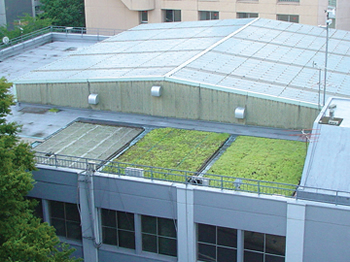
The lab evaluates clean and comfortable interior environments made by HVAC, etc., energy consumption, and environmental impact. The goal of the lab is to create high quality interior environments using small amounts of energy with minimum environmental impact. We also look at hot-water supply and lighting, as well as zero energy designs for buildings and homes. While numerical computation is the main methodology used in our investigations, experiments and surveys on and off campus are also encouraged. All of our seniors and graduate students work on thesis projects, and repeated number crunching and rerunning experiments are par of the course in their pursuit for new discoveries. Through their projects, we teach our students to overcome obstacles and to become valuable members of society.
Laboratory of Architectural History (Uchida Laboratory)
The study of architectural history is the process of uncovering the wisdom
that creates new architecture.

Good architecture isn’t simply about the pursuit of beautiful designs, seismic resistance, and comfortable interiors. What we aim to do is to propose ways to create better environments for people’s lives through architecture. Architects continue to search, study, and ponder about this question to provide an answer. There are two ways to find the answer to such a question. One is to study new buildings designed by contemporary architects and to understand their intentions. Another is to study historical buildings, which is a treasure trove of people’s wisdoms. Unearthing such a trove is an effective way for finding answers to age-old questions. We invite you to explore the past to find your trove.
Laboratory of Disaster Risk Management (Shumuta Laboratory)
Identifying the vulnerability of cities to disasters and preparing for the next disaster.
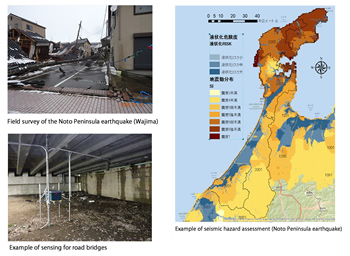
The main research theme is to strengthen the resilience of entire regions, including building structures and social infrastructure. While social infrastructure is ageing and depopulation is increasing as a social problem, there are concerns about the intensification of weather-related disasters due to global warming, and the possibility of large-scale earthquakes, such as the 2024 Noto Peninsula earthquake, is also increasing. In recent years, the mechanisms of disaster occurrence have become more complex and diverse, and the likelihood of disasters occurring that cannot be dealt with by conventional rules of thumb has increased. Our laboratory is actively engaged in research to understand the realities of the site using sensing technologies that reveal natural external forces such as seismic motions and wind speeds, as well as the strength characteristics of structures and ground. We combine the collected data with the latest analysis techniques and develop technologies that enable simulation, and study disaster prevention and mitigation measures in areas with high disaster risk.
Residence Design Laboratory (N.Suzuki Laboratory)
Identifying the vulnerability of cities to disasters and preparing for the next disaster.
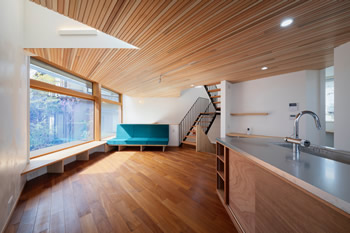
In today’s world, residential design is not only the act of imagining homes that form the foundation of human life, but also an intellectual pursuit where we can express our intentions and values through architecture.
This design process can be seen as a form of self expression toward society, and it is through its ability to combine different kinds of thinking—from practical aspects like economics and technology to more abstract ideas like aesthetics and philosophy—that it becomes an inherently fascinating architectural endeavor.
By finding meaning in the simple act of drawing a line and through the process of hesitation, exploration, and trial and error in the early stages of design, our ideas and approach to space take shape. This design journey itself forms the core of creative thinking in residential architecture.
In addition, our research group focuses on how housing can build meaningful connections with local communities, and how we can apply the concept of a “regional circular symbiotic zone” in architectural practice. Through both theoretical analysis and practical involvement in real residential design projects, we explore these topics from multiple angles.
Housing Design Laboratory (Tachibana Laboratory)
Designing the Relationship between Housing and Local Communities.

The relationship between housing, work, and daily life is changing significantly. Studying living environments and social contexts from present and past perspectives, we propose housing that supports a prosperous future lifestyle. Exploring modern and contemporary housing, traditional settlements, and lifestyles that reintegrate production and consumption, we design architecture and interiors that contribute to local communities.
Laboratory of Building Environment and Services (Serikawa Laboratory)
Studying realizing comfortable building environments with small environmental load
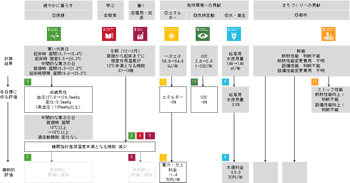
Our laboratory presents evaluation methods for housing performance. It is in demand to promote housing that simultaneously achieves a healthy environment with comfortability for those who stay inside and a reduced impact on the global environment. If buildings with high environmental performance are properly assessed, they will be built more in the future. Our evaluation through calculation or actual measurement would include:
- how much better thermal comfort can be achieved by improving the thermal performance of buildings
- how much energy and cost can be saved by replacing the equipment with a more efficient one
Taking advantage of being newly founded, our laboratory values students' initiative in exploring methods of study.
Laboratory of Urban Design (Sogabe Laboratory)
A place to explore new possibilities together

Looking at the reality of society and cities, what kinds of relationships are possible? The lab pursues the possibilities through architecture. We look into different approaches such as proposing specific venues for communication and creating new environments for community meetings. While we aim to look at a variety of possibilities, we emphasize practicality as well as unique points of view that go outside the box. We encourage students to engage actively in their concentrated exploration. This lab is not a place to show off what you know, but a place to discover what you don’t know. The lab is a place for exploring new possibilities in architecture.
Laboratory of Architectural Planning (Nakai Laboratory)
Thinking and planning spaces that enrich people's lives and society

Spaces have character. Some spaces are fun while others are calm or exciting. Spaces talk to us using their own set of rules to create messages, separate from what the building is for or how it is built. One of the most important things in creating rich spatial experiences in buildings and in cities is to learn the language of spaces, and to unlock the possibilities of spatial expression. Our lab encourages students to read and think about how spaces work, and create spatial languages and experiences. Our students research specific subjects in order to gain systematic understanding of spatial expressions and undertake design work as thesis projects or design proposals. Our ultimate goal is to make a contribution to society by discovering the possibilities of architectural and urban spaces.
Laboratory for Architectural Conservation and Utilization (Nomura Laboratory)
Inheriting the Value of Cities and Architecture, and Revitalizing Them to Meet the Demands of Our Time
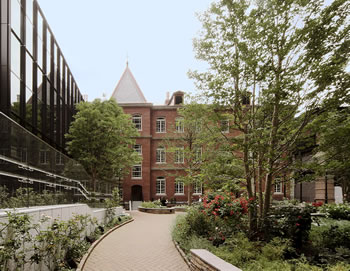
Traditionally, urban development has relied on a scrap-and-build approach—demolishing old structures to make way for new ones. However, in the era ahead, the focus must shift toward revitalizing the existing building stock through renovation and conversion.
This is particularly important for historic buildings, which embody singular and irreplaceable value. By first identifying and articulating these values, and then adapting their functions to contemporary needs, we can create architecture that new construction alone can never achieve.
We refer to this approach as “Inherited Design”, a design philosophy that seeks not only to preserve but also to evolve. Our research explores a wide range of methods for passing down architectural value, including not only real-world architectural interventions but also digital archiving, virtual reality environments, and other emerging tools for cultural transmission.
Laboratory of Sustainable Building Structures (Fujita Laboratory)
Learning and thinking about a wide range of topics from
the "framework" of architecture to "global environmental architecture"
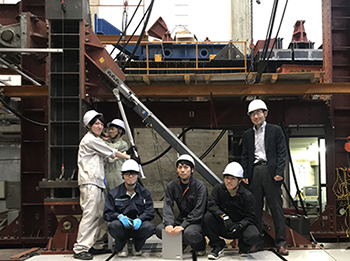
Our laboratory conducts research on a wide range of topics, from construction methods that classify building structures into frameworks, members, joints, and materials, to analytical experiments and analysis, and design to realize these methods.
With the diversification of the needs of the times, buildings must not only meet the performance requirements of strength, use, and beauty, but must also be environmentally friendly. The field of steel structures is an interesting field in which we can develop new technologies such as damping materials and long life by considering construction methods using stable quality materials such as steel and conducting various experiments and analyses. As a response to global environmental issues in the field of steel structures, we are developing a wide range of research themes, including buckling-restrained braces, member reuse, steel-wood composite structures, mechanical crack repair methods, and corrosion, and we are also applying the research results to actual buildings. In addition, we are actively engaged in exchange and joint research with people from various fields, including research institutes, universities, and companies outside the university. Our goal is to enhance our research activities while always collaborating with society.
Laboratory of Architectural History (Matsukuma Laboratory)
Research on Modern Architectural History and Design Methodology
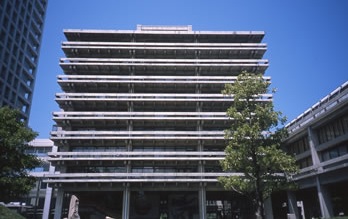
This Laboratory are conducting research on the history of Modern Architecture, which is based on industrialization, the direct source of the modern living environment that has shaped our modern lives, and on the ideas and design methodologies of the architects who pioneered it. In particular, we focus on Kunio Maekawa, who studied under Le Corbusier and Antonin Raymond and led modern architecture in Japan before and after World War II, and Junzo Sakakura, who also studied under Le Corbusier, as well as Togo Murano, Junzo Sakakura, Junzo Yoshimura, Shintaro Urabe, Kenzo Tange, Masato Otaka, Azusa Kito and others. We progress the project based on architectural archival materials such as original design drawings and photographs, and also involved in the planning and supervision of various architectural exhibitions. Furthermore, I am researching methods of preservation and renovation, and involving as a member of the committee to study the seismic retrofitting of the Kagawa Prefectural Office Building (1958/Kenzo Tange) and the World Peace Memorial Cathedral (1954/Togo Murano), among others. Taking advantage of every opportunity, we would like to pass on these experiences to the next generation.
Laboratory of Environmental Acoustics and Lighting (Yasuda Laboratory)
Studying the built environment and thinking about the quality of space and quality of life

Our focus is on quality-of-space elements – namely light and sound – that are closely related to Quality of Life. The lab specializes in sound, specifically, in basic research such as developing numerical analysis methods for noise control, and understanding acoustic properties of building materials to create better sound environments. We also perform applied research such as development of sound insulating structures to deal with floor impact noise, which is one of the main noise issues in multi-story housing. Architectural design often emphasizes visual aspects, but unwanted noise is one of the most common issues that come up after the building is occupied. We urge students to become more aware of sound in architecture.
Laboratory of Urban Planning (Yamaga Laboratory)
Let's think about the present and future of cities.

We research and analyze ever-changing urban spaces, and propose our visions for urban communities. Cities are reflections of society, systems, cultures, and how people live; cities must change as these factors change. Because our society is aging with fewer children, we must change the way we think about city planning. No longer are our cities growing and expanding, but they are now shrinking. We must also rethink architecture as building blocks of our changing cities. As a part of putting our investigation into practice, we get involved in planning the neighboring communities. By finding out what kinds of issues people have and what they find attractive or useful, students begin with things they can do on their own. We encourage students to become actively involved in community development through activities such as managing workshops for the residents.
Laboratory of Earthquake & Wind Resistant Structures (Yoshie Laboratory)
Evaluating the earthquake resistance, wind resistance, safety, and functionality appropriately to design safe and secure architectures.
We analyze the behavior of buildings with vibration control and seismic isolation structures against earthquakes and windstorms, and conduct research on methods for predicting the behavior of vibration control and seismic isolation structures subjected to earthquakes and wind, and on methods for verifying structural safety and design methods. In recent years, seismic isolation and vibration control structures are getting taller, resulting in more severe wind loads, but because of the trade-off relationship between seismic load and wind load, it is not possible to achieve a design with a sufficient margin for each. Correct and rational understanding of the behavior of structures against earthquake and windstorm is the only way to ensure and improve overall structural safety. Through this research, we hope to contribute to the improvement of structural safety of buildings.